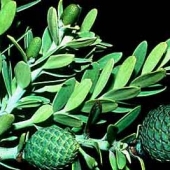Please select root levels for the menu
NZ Plants
Libocedrus bidwillii - pahautea, mountain cedar
Cypress family: Cupressaceae
-
Mature foliage
L Jensen
View picture -
Bark
L Jensen
View picture -
Juvenile plant, spreading needle leaves
L Jensen
View picture -
Detail of spreading leaves
L Jensen
View picture -
Juvenile, first flattened scale leaves
L Jensen
View picture -
Juvenile, flattened branch
L Jensen
View picture -
Pollen cones
J Braggins
View picture -
Seed cone
J Salmon
View picture
Libocedrus bidwillii, is a tall slender tree with small scale-like leaves that are compressed and flattened to the stem into four rows forming a lateral pair and a dorsal-ventral pair. The ultimate branchlets are four-angled in cross section and lateral and dorsal leaves are almost similar in size. Seed cones are small and woody with a distinctive sharp spine on the bracts and release seeds while attached to the tree.
An endemic species found at higher elevations on the North Island and at lower levels on the South Island.
Libocedrus is a small genus of six species, two endemic to New Zealand and one endemic to Chile and three endemic to New Caledonia.
Named after the English botanist and explorer, John Carne Bidwill (1815-1853), a collector of plants in New Zealand and Australia.
Vegetative characteristics |
Reproductive characteristics |
|---|---|
Adult plant form: tree up to 30 m |
Pollen and ovule cones: on the same tree |
Adult leaf form: sheathing, triangular, closely overlapping adjacent leaves |
Pollen cone: 2-5 mm long with 7-9 fertile scales |
Adult leaf size: both lateral and dorsal-ventral leaves are up to 2. 5mm |
Ovule cone: ovoid, 5-8 mm wide. with two sterile and two fertile bracts arranged in opposite pairs; a small fertile cone scale on inner surface of each of the two uppermost bracts |
Adult leaf arrangement: in pairs arranged in two lateral rows and two dorsal-ventral rows |
Ovule position: two upright ovules on the upper surface of each fertile cone scale |
Juvenile leaf form: linear, needle-like changing to overlapping triangular leaves; lateral leaves larger than dorsal ventral |
Ovule coverings: a single covering (integument); after fertilisation this is covered by the enlarged fertile cone scale |
Juvenile leaf size: up to 10 mm |
Ovule pore (micropyle): directed upward |
Juvenile leaf arrangement: initially spiral |
Mature seed cone: small and woody, 8-10 mm long; a curved spine is on the back of each woody bract; up to four winged seeds are released when the cone opens |




